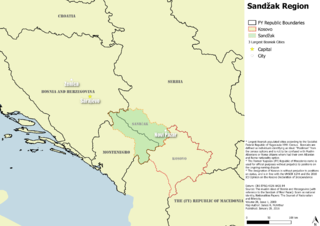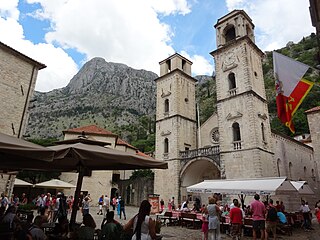
Montenegro is a country in Southeastern Europe. It is a part of the Balkans and is bordered by Bosnia and Herzegovina to the north, Serbia to the northeast, Kosovo to the east, Albania to the southeast, Croatia to the northwest, and the Adriatic Sea to the west with a coastline of 293.5 km. Podgorica, the capital and largest city, covers 10.4% of Montenegro's territory of 13,812 square kilometres (5,333 sq mi), and is home to roughly 31% of its total population of 621,000. Cetinje is the former royal capital of Montenegro and is the location of several national institutions, including the official residence of the president of Montenegro.

Sandžak, also known as Sanjak or as Raška by Serbs, is a historical geo-political region located in the southwestern part of Serbia and the eastern part of Montenegro. The name Sandžak derives from the Sanjak of Novi Pazar, a former Ottoman administrative district founded in 1865.

Shkodër County is a county in northwestern Albania, with the capital in Shkodër. The county spans 3,562 square kilometres (1,375 sq mi) and had a total population of 197,177 people as of 2021. The county borders on the counties of Lezhë, Kukës and the country of Montenegro. The county consists of five municipalities: Fushë-Arrëz, Malësi e Madhe, Pukë, Shkodër and Vau i Dejës.
The demographic history of Montenegro can be shown through census results and official documents which mention demographic composition.

Ulcinj is a town on the southern coast of Montenegro and the capital of Ulcinj Municipality. It has an urban population of 10,707 (2011), the majority being Albanians.

The Democratic Union of Albanians is a conservative political party of the Albanian minority in Montenegro.

Tuzi is a small town in Montenegro and the seat of Tuzi Municipality, Montenegro. It is located along a main road between the city of Podgorica and the Albanian border crossing, just a few kilometers north of Lake Skadar. The Church of St. Anthony and Qazimbeg's Mosque are located in the centre of the town. Tuzi is the newest municipality in Montenegro, having been an independent municipality since 1 September 2018.

The Kingdom of Montenegro was a monarchy in southeastern Europe, present-day Montenegro, during the tumultuous period of time on the Balkan Peninsula leading up to and during World War I. Officially it was a constitutional monarchy, but absolutist in practice. On 28 November 1918, following the end of World War I, with the Montenegrin government still in exile, the Podgorica Assembly proclaimed unification with the Kingdom of Serbia, which itself was merged into the Kingdom of Serbs, Croats and Slovenes three days later, on 1 December 1918. This unification with Serbia lasted, through various successor states, for almost 88 years, ending in 2006.

Plav is a town in Polimlje region in north-eastern Montenegro. It has a population of 3,717. Plav is the centre of Plav Municipality.

Rožaje is a town in northeastern Montenegro.
Albanians in Montenegro are an ethnic group in Montenegro of Albanian descent, which constitute 4.91% of Montenegro's total population. They are the largest non-Slavic ethnic group in Montenegro.

The Catholic Church in Montenegro is part of the worldwide Catholic Church, under the spiritual leadership of the Pope in Rome. There are 21,299 Catholics in Montenegro, and they form three and a half percent of the population. Most Catholics are ethnic Albanians, Montenegrins and Croats.

Religion in Montenegro refers to adherents, communities, institutions and organizations of various religions in Montenegro. While Eastern Orthodox Christianity is the dominant religious denomination in Montenegro, there are also sizable numbers of adherents of both Catholic Christianity and Islam.

Languages of Montenegro are languages that are spoken in Montenegro. According to the Constitution of Montenegro, adopted in 2007, Montenegro has only one official language, specified as Montenegrin. However, at the 2011 census, 42% of the population declared Serbian to be their native language, while Montenegrin was the second most common at 37%. Both Montenegrin and Serbian are standardized varieties of the Serbo-Croatian language, alongside Bosnian and Croatian. However, an official standard for Montenegrin is still in the process of being formulated. The Montenegrin language is written in the Latin and Cyrillic alphabets, but there is a growing political movement to use only the Latin alphabet.

The siege of Scutari, also referred to as the siege of Shkodër, known in Turkish as İşkodra Müdafaası(in Turkish) or İşkodra Savunması, took place from 28 October 1912 to 23 April 1913 when the army of the Kingdom of Montenegro defeated the forces of the Ottoman Empire and invaded Shkodër.
Independent Albania was proclaimed on 28 November 1912. This chapter of Albanian history was shrouded in controversy and conflict as the larger part of the self-proclaimed region had found itself controlled by the Balkan League states: Serbia, Montenegro and Greece from the time of the declaration until the period of recognition when Albania relinquished many of the lands originally included in the declared state. Since the proclamation of the state in November 1912, the Provisional Government of Albania asserted its control over a small part of central Albania including the important cities of Vlorë and Berat.

The Albania women's national football team represents the country of Albania in international football and is controlled by the Albanian Football Association which is headquartered in the city of Tirana. The team is affiliated with UEFA and competes in the two major professional tournaments, the FIFA World Cup and the UEFA European Championship.

The Albanian revolt of 1911 or the Malësori uprising of 1911 was one of many Albanian revolts in the Ottoman Empire and lasted from 24 March 1911 until 4 August 1911 in the region of Malësia.

Adrian Lulgjuraj is a Montenegrin-born Albanian singer. Together with Bledar Sejko, he represented Albania in the Eurovision Song Contest 2013 in Malmö with the song "Identitet". The song failed to qualify for the final.
Battle of Ulcinj was a battle between the Ottoman forces of Dervish Pasha and Albanian irregulars in the year of 1880 at the region of Kodra e Kuqe, close to Klleeznes. The area of Ulcinj had been handed over to Montenegro by the Ottomans after the Albanians previously fought against the annexations of Hoti and Grude. The Great powers instead pressured the Ottomans to hand over the area of Ulcinj, but also here the Albanians refused. Eventually the Great powers forced the Ottomans to take actions against the League of Prizren, ending the resistance and successfully handing over the town of Ulcinj to Montenegro.
















